Table to Trash
I’ve worked on and off as an event chef and manager for the past eight years in Los Angeles and have thrown away massive amounts of food. It is one of the reasons why I decided to go back to school to get a master’s degree in urban sustainability. The excess and waste was eating me up.
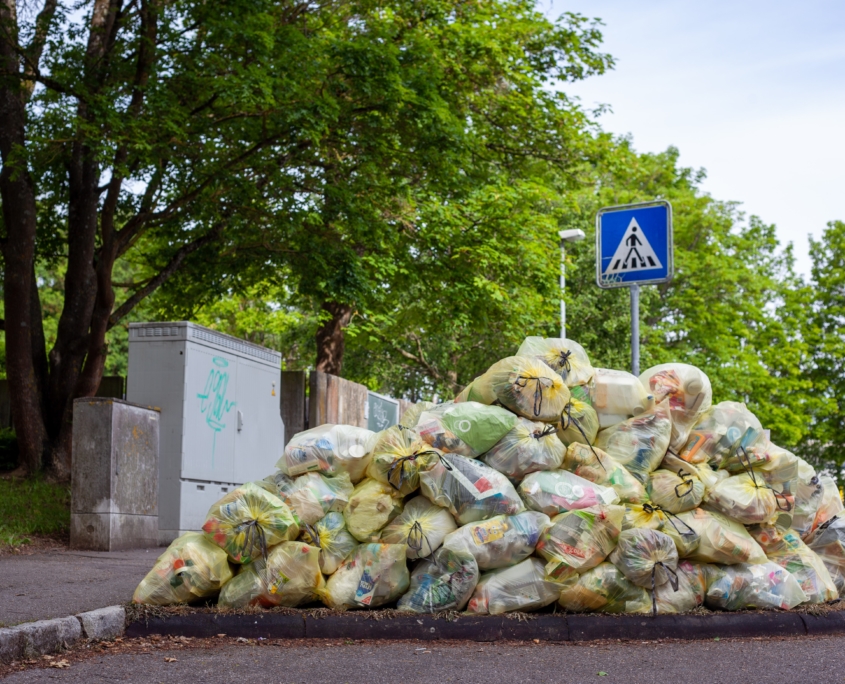
Photo by Jasmine Sessler
According to this 2021Guide, the U.S. wastes approximately 40% of its food supply – nearly 40 million tons of food every year. Globally, 1.4 billion tons of food is wasted and contributes to 11% of global greenhouse gas emissions. I have lived most of my life conscientiously about waste in its many forms, from electricity to petrol and also food. So, shifting into work that has a substantial waste byproduct was emotionally challenging.
I’m running late. I live on the northeast side of Los Angeles and I have a gig across town in Beverly Hills. I park on a steep, curving street and check my phone. 4:14 p.m. One minute to walk up the hill in my Danskos to my next gig as an event chef. I start jogging as it seems to take forever to walk past one extra-large home.
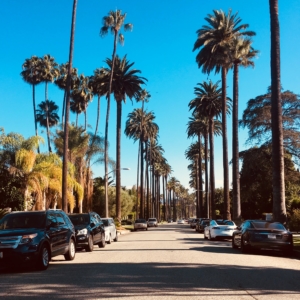
Beverly Hills. Photo by Ashlee Attebery.
I button up the neck on my chef’s coat as I stroll up to a white mansion with Grecian columns. A white baby grand piano is in the center of a gated stone-paved driveway entrance, being played by a man in a white-tailed tuxedo. I join the other six chefs – all male – we hug and bro out for a bit.
“Ok, everyone clock-in, unload, guests arrive at 6:30 sharp. Champagne trays out by 6:20,” directs the event’s captain, an extremely fit, not-tall man with tight pants and a huge presence. “The ice sculpture goes on the veranda. This is where the vodka and caviar station will be set up. Careful!” says the captain to the young, cute actors by day, catering servers by night.
We quietly unload the black Mercedes van. Chefs proceed methodically, moving heavy black cambros full of a myriad of different hot dishes with meat and finely sliced vegetables in hotel pans. Then, coolers with milky black Ossetra caviar, oysters and other mollusks, boiled crustaceans, and an array of cheeses. Lastly, like dessert, come out the speed racks wrapped in plastic wrap full of perfect pastries and delicate white and gold cakes. We pile it all in the garage and then close the door. This is the “Second Kitchen.”
Another chef and I move to the enormous kitchen in the house. It has every appliance I could imagine, industrial kitchen stoves and hoods without a spot reflecting any previous use. We quickly cover the marble countertops with plastic wrap. Then cover the floors with mats. There mustn’t be any evidence of us having been there.
I gingerly dump a cooler of caviar on the veranda and then, as I walk through the dining room, I notice a famous piece of art taking up the whole wall that must be valued at hundreds of millions of dollars. I feel small next to it – with my time and skill being $20 an hour – reminding me I am worth significantly less than the canvas and paint hanging next to me.
Near the glistening pool, I set up the pasta station and put ladles in the vessels for the various sauces including tomato, Alfredo, and garlic butter. Then, as I ascend up the stairs to the veranda, I notice the moon is full-ish and glowing down on the ice sculpture now acting as a cooler for various types of vodka, including the silvery Beluga Noble and opaque Belvedere, now dripping with condensation. A tower of cooked shrimp, thick king crab legs, and smallish French langoustines is being assembled. The oyster shucker is setting up his station. He has been shucking for fifty years and has arthritis but told me he “can never retire on this wage” and is grateful people continue to hire him.
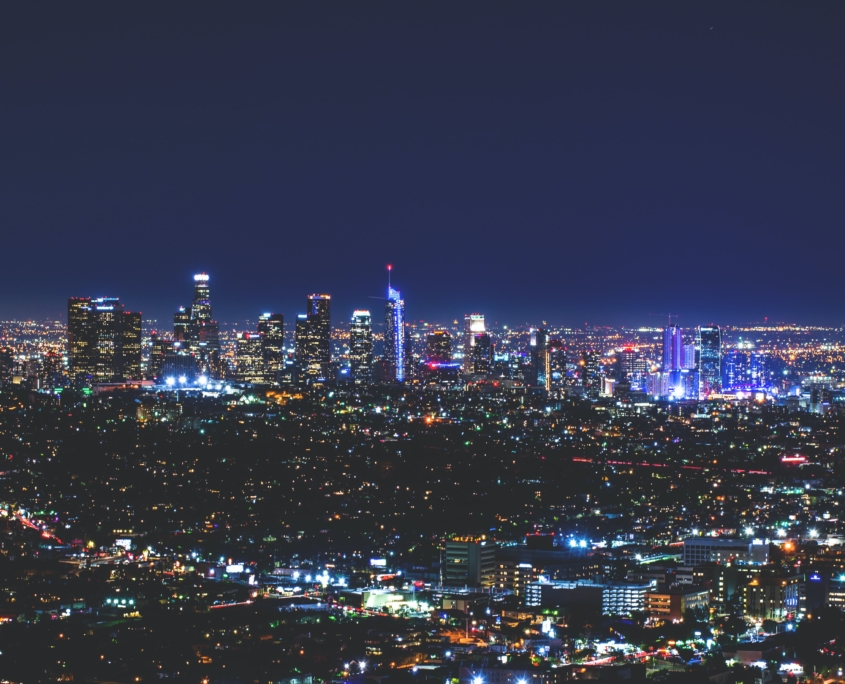
Los Angeles skyline at night. Photo by David Everett Strickler
The evening, late spring view out onto the megalopolis of Hollywood toward DTLA is shimmering and velvety like the spread of $300/oz Beluga sturgeon Huso huso caviar before me. I notice the juxtaposition of finding beauty in my surroundings at the same time as being an invisible fixture to the well-oiled machine of event production. I cannot help feeling privileged at being able to witness the ephemeral art installations wealth affords.
I venture back to the plastic-wrapped marble to begin to assemble minuscule morsels for tray-pass apps. I set out a board and place six buckwheat blinis in a row. I grab a piping bag from the cooler, cut off the tip and squeezed a squirt of crème fraîche on each, then put the bag in a bowl of ice. I take out a miniature mother of pearl spoon from a black felt case and open the blue aluminum tin of Caviar – Petrossian Paris – with an archaic ship with red sails on the lid. I scoop a small dollop of the mini gelatinous eggs onto each bed of crème.
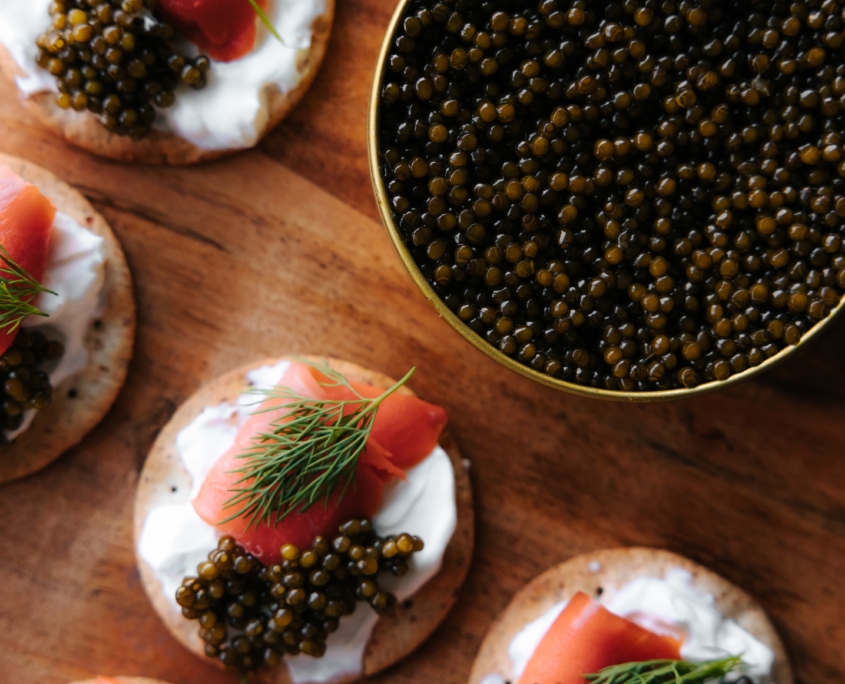
Caviar and salmon appetizer. Photo by Tyler Nix
Next, I start on the quail egg app. While tweezing microgreens onto salmon roe, the owner of the company comes in huffing and puffing about the amount of truffle shavings to use as garnish. I keep my head down and place the row of blinis onto a slate square for an emaciated young man in all black to tray pass. The event runs smoothly.
Two hours later, I dump ten pounds of seafood into the trash, followed by all of the leftover tiny bites with shaved asparagus, yuzu foam, and tweezed micro flowers. Next goes the hanger steak, cambros of pasta, and deli cups of intricately cut items. All goes into triple-lined black bags, six sacks in total of delicious food.
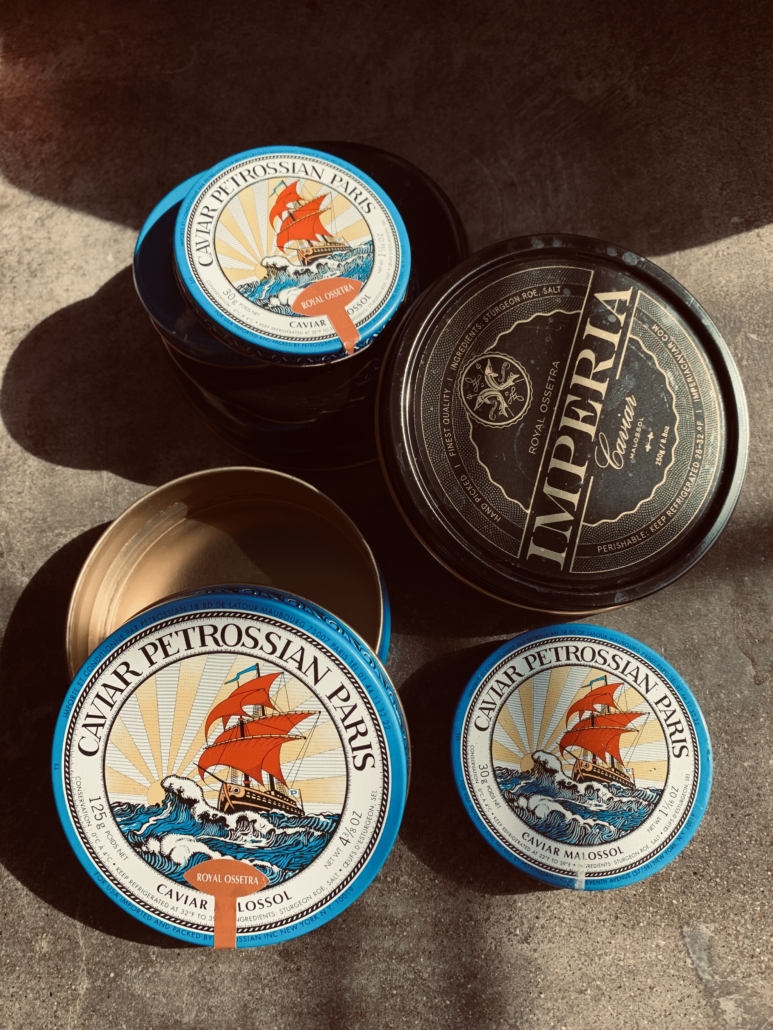
Caviar containers after an event. Photo by Franz Franta
Like a Tibetan sand painting, I created hundreds of bite-sized works of art that lasted as long as a server walking through a room. Then, swept into the oblivion of a black trash bag. Organic, local, wild-caught, free-range, grass-fed, farm-to-table, table to trash.
Everything is stacked back in the second kitchen. I’ve rolled up my knives and tweezers and prepared to depart. A TESLA Model X has replaced the piano in the center of the driveway and is in “Party Mode, ” Trans Siberian Orchestra blaring from its speakers and the winged doors open. People begin to leave amidst the disco lighting. I shuffle back down the hill in my clogs and shut the door to my car.
Exiting Beverly Hills on Sunset Boulevard, the streets change when I hit Hollywood. The silent manicured ambiance shifts to sirens and nightlife. At a stop light, I see a man searching through the trash, sifting through black bags similar to the ones I just filled with uneaten food.
Franz Franta is an urban sustainability practitioner and Antioch University MFA graduate. With an international background and previous masters’ in urban design, she concentrates her writing on how cities impact the psyches of citizens. She lives in Los Angeles.





